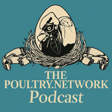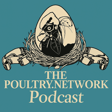
EP 16 Broiler performance, co-grazing risks and new breeding technology
A chilly house, ten uncooperative sheep, and some serious industry talking points.
In this episode of the Poultry Network Podcast, hosts Tom Woolman and Tom Willings catch up on the latest from Aviagen’s producer roadshows and discuss why UK broiler performance is comparing favourably with results seen elsewhere in Europe. While some of the improvement may reflect down-stocking, they note that good margins are allowing reinvestment in housing, equipment and farm infrastructure – small but important details that continue to lift performance.
That discussion leads neatly into one of the more striking messages from Poultry Network Live, where Gordon Hickman OBE warned producers against grazing poultry alongside sheep or cattle. Similar advice has since been circulated by the Rare Breeds Survival Trust. The Toms consider what this could mean in practice for mixed farms with free-range or organic flocks, and how any future policy shift might test the balance between maintaining livestock enterprises and outdoor access for laying hens.
The conversation broadens to the global disease picture following a recent BBC documentary on “the next pandemic”. The programme focused on H5N1 infections now found across more than a thousand dairy herds in the United States. The hosts reflect on scientists’ concern that the virus is becoming more resilient in mammalian conditions – a reminder that avian influenza remains a live risk for agriculture and public health alike.
A second emerging story catching their attention is the concept of “layers laying broilers.” Developed by the international research project NextHen, it involves inserting broiler germ cells into sterile layer embryos, creating parent stock capable of laying broiler chicks rather than conventional hatching eggs. The technology could, in theory, simplify breeder management, free up rearing capacity and improve efficiency – but also raises complex regulatory questions. The company claims the process does not constitute genetic modification, yet it is unclear how that position would be treated in the UK or EU markets.
The pair also take a lighter look at their own livestock ventures. Tom Willings reports on the challenges of integrating his small flock of Beulah crosses and Black Welsh Mountain ewes, while Tom Woolman admits to discovering an unexpected resident at his new home – a peacock that insists on visiting his window each afternoon.

